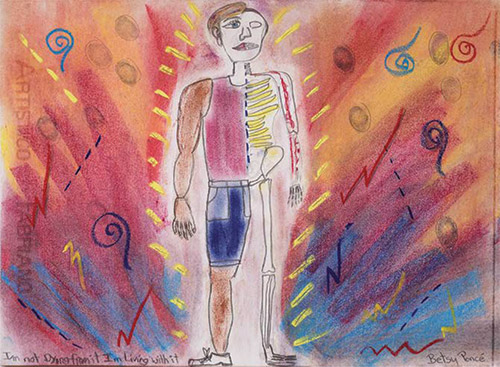
The HIV Prevention Trials Network (HPTN) announced that one injection every eight weeks showed strong efficacy for preventing HIV in cisgender women.
The HPTN 084 study compared a long-acting injection of cabotegravir (CAB LA), a drug still in development, to a daily oral tablet, Truvada, for HIV pre-exposure prophylaxis (PrEP). Both regimens were highly effective at preventing HIV in this study of cisgender women, the study found.
On the strength of the results, the independent HPTN 084 Data and Safety Monitoring Board (DSMB) recommended that the study be unblinded going forward after reviewing the results on November 5. The trial was originally designed to continue through 2022 as a blinded study (where participants do now know what medication they are receiving). Participants given Truvada will be able to choose the injections as the drug becomes available.
HPTN 084 is sponsored by the U.S. National Institute of Allergy and Infectious Disease (NIAID), part of the National Institutes of Health (NIH). According to NIH, this is the first time a large-scale clinical trial has shown a long-acting injectable form of HIV prevention to be highly effective for cisgender women. The trial enrolled 3,223 cisgender women ages 18 to 45, in seven African countries.
“The results from HPTN 084 are incredibly important for women in Africa where lowering HIV incidence remains a priority,” said Dr. Sinead Delany-Moretlwe in an HPTN press release.
The demonstrated efficacy will help bring CAB LA PrEP to women all over the world, not just Africa.
Dr. Delany-Moretlwe, who is the protocol chair for HPTN 084 and director of research at Wits Reproductive Health and HIV Institute at the University of the Witwatersrand in Johannesburg, said, “We know that adherence to a daily pill continues to be challenging, and an effective injectable product such as long-acting CAB is a very important additional HIV prevention option for them. We are grateful to the women who volunteered for this study and the research staff, as this study would not have been possible without their commitment to HIV prevention.”
The drug earlier last year had also demonstrated efficacy for cisgender men and transgender women who have sex with men, in the HPTN 083 trial. That study was also unblinded early as a result and that research also continues.
The Phase 3 HPTN 084 trial was launched in late 2017. In the data presented in November, of the 38 women in the study who had acquired HIV during follow up, four had been given CAB LA (for an incidence rate of 0.21%) and 34 had been given Truvada (1.79%). The research team declared superiority for PrEP with CAB LA based on statistical criteria. NIH reported that, “The higher-than-expected level of adherence to [Truvada] throughout the study and overall low incidence rate in both arms of the study clearly demonstrate both drugs were highly effective at preventing HIV acquisition.”
CAB LA is also being studied for HIV treatment, in combination with a long-acting injectable formulation of rilpivirine (Edurant, RPV).
In another PrEP study, once-monthly oral islatravir was scheduled to enter Phase 3 clinical study in women and adolescent girls with high risk for HIV acquisition. The IMPOWER 22 trial is scheduled to begin this year in sub-Saharan Africa, where more than half of the world’s new HIV acquisitions take place.
Islatravir is being developed by Merck & Co. for HIV treatment as well as for PrEP. It is a nucleoside reverse transcriptase translocation inhibitor (NRTTI), a new drug class. Merck announced a collaboration with the Bill & Melinda Gates Foundation for funding of the Phase 3 pivotal trial, which is used to bring a drug to regulatory approval.
“We will not turn the tide on HIV globally until we turn the tide on the virus in Africa, and this clinical trial seeks to help advance this effort through its focus on women, especially younger women, who remain disproportionately at risk on this continent,” said trial investigator Professor Elizabeth Anne Bukusi, PhD, principal clinical research scientist and co-director of the Research Care Training Program at the Center for Microbiology Research of The Kenyan Medical Research Institute, in a press release from Merck.
Islatravir PrEP is also being studied in other groups with particular vulnerability to HIV acquisition, such as gay men.
ViiV Healthcare, a pharmaceutical company which focuses on drug development in HIV treatment and prevention, has released a new report about gay and bisexual Latinos living with, or vulnerable to, HIV.
“For Latinx men, including cis and transgender men, who have sex with men (MSM), navigating sexual and cultural identity amid social pressures poses significant challenges to accessing healthcare,” the report says.
“Latinx communities in the U.S. face many of the same challenges as other communities of color, including poverty, poor access to education, poor housing, and unreliable or unsafe public transportation, all of which impact health outcomes for Latinx MSM. On top of this, anti-immigrant laws spread fear and insecurity that keep these men and their communities from utilizing life-saving services including healthcare. When they do attempt to access care, many experience fear, discrimination, and rejection from service and clinics,” the company reported in a statement.
“Here As I Am” (Aqui Como Soy) features findings based on firsthand accounts gathered through community-based research, facilitated by the Latino Commission on AIDS. The report examines five key issues that arose:
• Family and community are central to men’s lives and identities, shaping their health and wellness for better or worse
• Interruptions in care happen for many reasons beyond men’s control
• Anti-immigrant sentiment and anti-immigrant laws have a powerful effect on men’s health
• Men want diverse and responsive care that reflects their needs, identity, and language, and
• Resilience is activated through networks and services by and for Latinx men, especially youth
The report’s findings will be incorporated into ViiV’s Positive Action for Latinx Men program, “a community-giving initiative.”
Listen to some of the men from the report tell their stories and read the report itself, available in Spanish and English; viivhealthcare.com/en-us/positive-action-for-latinx-men.
• An estimated 186,900 Hispanic/Latino gay and bisexual men were living with HIV in the United States
• An estimated 80% of all new diagnoses among Hispanics/Latinos were among gay or bisexual men
Source: Centers for Disease Control and Prevention HIV Surveillance Report 2018
In 2016, about 1 in 3 Hispanic/Latino gay and bisexual men living with HIV did not have undetectable viral load
Source: Centers for Disease Control and Prevention HIV Surveillance Data (June 2019)
Two pharmaceutical manufacturers specializing in the making of generics are bringing a strawberry-flavored HIV medication for pediatric use in resource-poor countries. The announcement was made by the Clinton Health Access Initiative and Unitaid on World AIDS Day, December 1.
The generic formulation of the powerhouse medication dolutegravir (DTG, brand name Tivicay) will be dispersible as a liquid. According to the two global health initiatives, generic strawberry dolutegravir for kids will cost $36 a year, a sharp discount from the $480 generic adult dose. There are 1.7 million children around the world living with HIV, said the announcement, with only half receiving antiviral therapy.
“Children in low- and middle-income countries often wait years to access the same medications as adults, hindering their quality of life, or even resulting in preventable deaths,” Unitaid executive director Philippe Duneton said. “This groundbreaking agreement will bring quality assured dispersible DTG to children living with HIV, helping them to remain on treatment and saving thousands of lives.”
Tivicay tablets are available in the U.S. for children weighing at least 77 pounds, but not for years after adult therapy came on the market. Development of pediatric therapy lags behind adult treatment. Dolutegravir is also contained in the single-tablet regimens Dovato, Juluca, and Triumeq. It is recommended for first-line HIV therapy in the United States and for use by pregnant women (under most circumstances).
The minimum weight needed by pediatric patients before they can be given Selzentry (maraviroc) HIV antiviral has been lowered from 22 pounds (10 kg) to 4.4 pounds (2 kg). Pediatric dosing is based on weight. Selzentry is not recommended for pre-term neonates. See the drug package insert for new data and changes added by the U.S. Food and Drug Administration (FDA).
Two new reference guides to help medical providers treat patients aging with HIV were released in November.
Incorporating New Elements of Care highlights screenings for common health and social needs of people aging with HIV. Putting Together the Best Health Care Team discusses how all members of a health care team can contribute to care.
“What was once considered a deadly disease, HIV is now a manageable, chronic condition that allows a nearly normal lifespan, thanks in large part to the Health Resources and Services Administration’s (HRSA) Ryan White HIV/AIDS Program (RWHAP) and expanded access to HIV treatment services and medical advancements,” wrote Laura Cheever, MD, ScM, of HRSA’s HIV/AIDS Bureau. “In 2018, 46.1% of RWHAP clients were aged 50 years and older. Of RWHAP clients aged 50 years and older receiving HIV medical care, 91.5% were virally suppressed.” Go to hiv.gov/blog/hrsa-s-hivaids-bureau-releases-two-new-aging-hiv-reference-guides.
The International AIDS Society (IAS) takes on COVID-19 once again in a conference focused on prevention. “Many HIV professionals are leading the COVID-19 response in their respective countries and conducting related prevention research,” IAS president and conference co-chair Adeeba Kamarulzaman said in a statement. “After the first IAS-hosted COVID-19 Conference in July 2020, I am excited to announce the second iteration that will help shape the global pandemic response.” The conference, to be held virtually February 2, focuses on prevention-related science, policy, and practice.
For more information, or to register go to covid19.iasociety.org.
The overall number of deaths in the U.S. directly related to HIV among people living with the virus was cut nearly in half between 2010 and 2018, according to an analysis by the U.S. Centers for Disease Control and Prevention (CDC). But decreases weren’t as significant for women, people of color, and people who live in the Deep South, underscoring health disparities.
The rate of deaths directly related to HIV dropped 48.4 percent—decreasing from 9.1 per 1,000 people living with HIV to 4.7 deaths per 1,000 people living with HIV (PLWH). The rate of non-HIV-related deaths also decreased, by 8.6%—from 9.3 in 2010 to 8.5 in 2017. CDC researchers examined data from the National HIV Surveillance System.
In 2017, more than 16,000 people living with HIV died—about 5,500 of those deaths were attributed to the virus.
“Continued efforts in diagnosing HIV early, promptly initiating treatment, and maintaining access to high-quality care and treatment are necessary for continuing progress in reducing deaths and eliminating differences across populations,” CDC reported in its summary.
“This is not just about the drugs. It’s the entire structure that supports people,” said Dr. Jeanne Marrazzo, Director of Infectious Diseases at the University of Alabama in Birmingham, in a New York Times article about the rate drop. “Sometimes that’s lost in the dialogue.”
The results were published in the CDC’s November 11 Morbidity and Mortality Weekly Report: bit.ly/MMWR-2020-11-20.
A new report highlights the needs of people age 50 and over who are aging with HIV, and offers recommendations to care providers. Produced by Grantmakers in Aging (GIA), Moving Ahead Together: A Framework for Integrating HIV/AIDS and Aging Services focuses on isolation and stigma, the need for holistic and integrated services, and updating government policies.
“People living with HIV age into a sort of no-man’s land that can be a lonely and potentially dangerous place,” said John Feather, PhD, GIA’s CEO. “Aging services and HIV services both deliver excellent care but have no history of working together, and people aging with HIV can get lost. The need for greater coordination, expertise sharing, and inclusion has been strongly affirmed by leaders in both sectors, and, importantly, by people who are themselves aging with HIV/AIDS.”
Recommendations were informed by leaders in the fields of HIV and aging, and through a virtual summit. Among them:
• Help geriatricians and primary care providers improve their knowledge of HIV in older people, including testing, prevention and sexual health counseling.
• Incorporate principles of trauma-informed care and increase cultural competence of providers and staff in all care settings, including senior centers and long-term care facilities.
• Help HIV specialists gain expertise in geriatric issues including multiple co-existing conditions, cognitive impairment, and HIV’s effect on aging.
• Co-locate and coordinate HIV and aging services, including case management and social services.
The report also includes first-person reflections, video interviews, and illustrations by older people living with HIV; it was supported by a grant from Gilead Sciences. GIA is a national membership organization of philanthropies. For more information and a downloadable PDF of the report, go to giaging.org/initiatives/hiv-and-aging.
Rochelle Walensky, MD, MPH, began her career in the mid-1990s fighting the HIV/AIDS epidemic. Chosen by president-elect Joe Biden as director of the U.S. Centers for Disease Control and Prevention (CDC), she'll play a key role in the fight against COVID-19 and managing the largest vaccine campaign in the country’s history.
Before her selection, she was the Chief of Infectious Diseases at Massachusetts General Hospital (MGH) and a professor of medicine at Harvard Medical School. An expert HIV/AIDS clinician passionate about health care equity and access to treatment, she helped lead MGH’s fight against COVID-19 since almost the start of the pandemic.
Her arrival comes after a challenging time that saw the CDC sidelined by the Trump administration, which often forced the agency to put political considerations ahead of medical science, tarnishing its reputation and sinking morale among its doctors and researchers.
“In selecting @RWalensky, Biden has chosen one of the most respected infectious disease docs in the world,” tweeted Jen Kates, a senior vice president at the Kaiser Family Foundation. “She has a long history working on HIV and has, in the past year, become a tour de force in addressing COVID. She’ll take the helm of CDC at perhaps its most critical moment.”
Walensky replaces Robert R. Redfield, MD, who was named CDC director in April 2018; the appointment does not require Senate confirmation.
New York City’s deputy commissioner for disease control has been named the new head of HIV prevention for the U.S. Centers for Disease Control and Prevention (CDC).
Dr. Demetre Daskalakis became the director of the Division of HIV/AIDS Prevention of the CDC’s National Center for HIV/AIDS, Viral Hepatitis, STDs, and TB Prevention (NCHHSTP) in late December. Known for his work in creating and leading many HIV and STI programs in New York City, Dr. Daskalakis is credited for reducing HIV rates in the city to historic lows.
“We are excited for him to bring this leadership and experience to DHAP to advance meaningful research, guide surveillance and programs, support and implement effective policy, and ultimately prevent HIV infections and increase health equity across the United States,” said NCHHSTP director Jonathan H. Mermin, MD, MPH, in a statement.
As deputy commissioner for the Division of Disease Control at the NYC Department of Health and Mental Hygiene, Dr. Daskalakis directed the city’s infectious disease control programs, including HIV, tuberculosis, sexually transmitted infections, vaccine-preventable diseases, and general communicable diseases. He was the department’s incident commander during the city’s measles outbreak in 2018–2019, and for the current COVID-19 pandemic.
Dr. Daskalakis, who grew up in Arlington, Virginia, attended NYU’s School of Medicine, completing his residency at Beth Israel Deaconess Medical Center in Boston. He completed clinical infectious disease fellowships at the Brigham and Women’s Massachusetts General Hospital combined program, receiving his master’s from the Harvard T.H. Chan School of Public Health. He has written or co-authored more than 50 scholarly articles, earning awards from the Treatment Action Group, the Latino Commission on AIDS, and GMHC.
He began his medical career as an attending physician in New York’s Bellevue Hospital, where he spearheaded several public health programs focused on community HIV testing and prevention. He has been a staunch advocate, addressing stigma, key social determinants of health, and making prevention options such as PrEP accessible and affordable to all.
“We have the tools at our hands to prevent infection and to keep people living with HIV healthy,” he said. “Our barrier to achieving this vision is no longer science; it is systemic racism, sexism, homophobia, and transphobia.”





